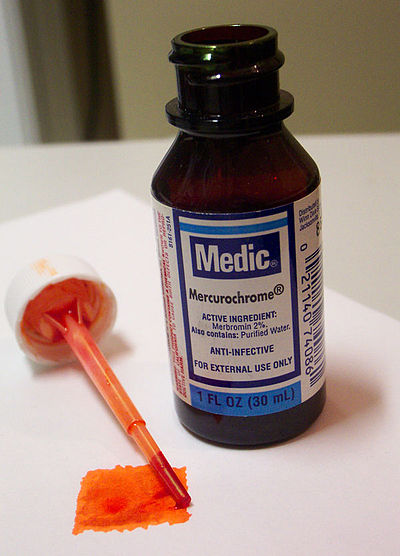Merbromin
Template:Chembox new Merbromin (marketed as Mercurochrome, Merbromine, Sodium mercurescein, Asceptichrome, Supercrome and Cinfacromin) is a topical antiseptic used for minor cuts and scrapes. It is no longer sold in the USA because of its mercury content. Merbromin is an organomercuric disodium salt compound and a fluorescein.

Uses
Merbromin's best-known use is as a topical antiseptic, however it, along with Merthiolate, has been ruled ineffective by the FDA, and is no longer approved. When applied on a wound, the dark red colour stains the skin, making the detection of any erythema or inflammation, indicative of infection, more difficult. Merbromin is also used as a biological dye used to mark tissue margins, and as a metal dye in industrial dye penetrant inspection to detect metal fractures.
Mercurochrome & Tinctures
Mercurochrome is the trade name of merbromin and (usually) of merbromin tinctures made of merbromin and alcohol or water (usually 2% merbromin to 98% alcohol or water).
Its antiseptic qualities were discovered by Johns Hopkins doctor Hugh H. Young in 1919. The chemical soon became popular among parents and doctors for everyday antiseptic uses and it was very commonly used for minor injuries in the schoolyard. The Food and Drug Administration (FDA) removed it from the "generally recognized as safe" and into the 'untested' classification to effectively halt its distribution in the United States in 1998 over fears of potential mercury poisoning. It is readily available in most other countries.
External links
Template:Antiseptics and disinfectants
da:Børnejod de:Antiseptikum#Mercuchrom it:Mercurocromo hu:Merbromin nl:Merbromine Template:WikiDoc Sources